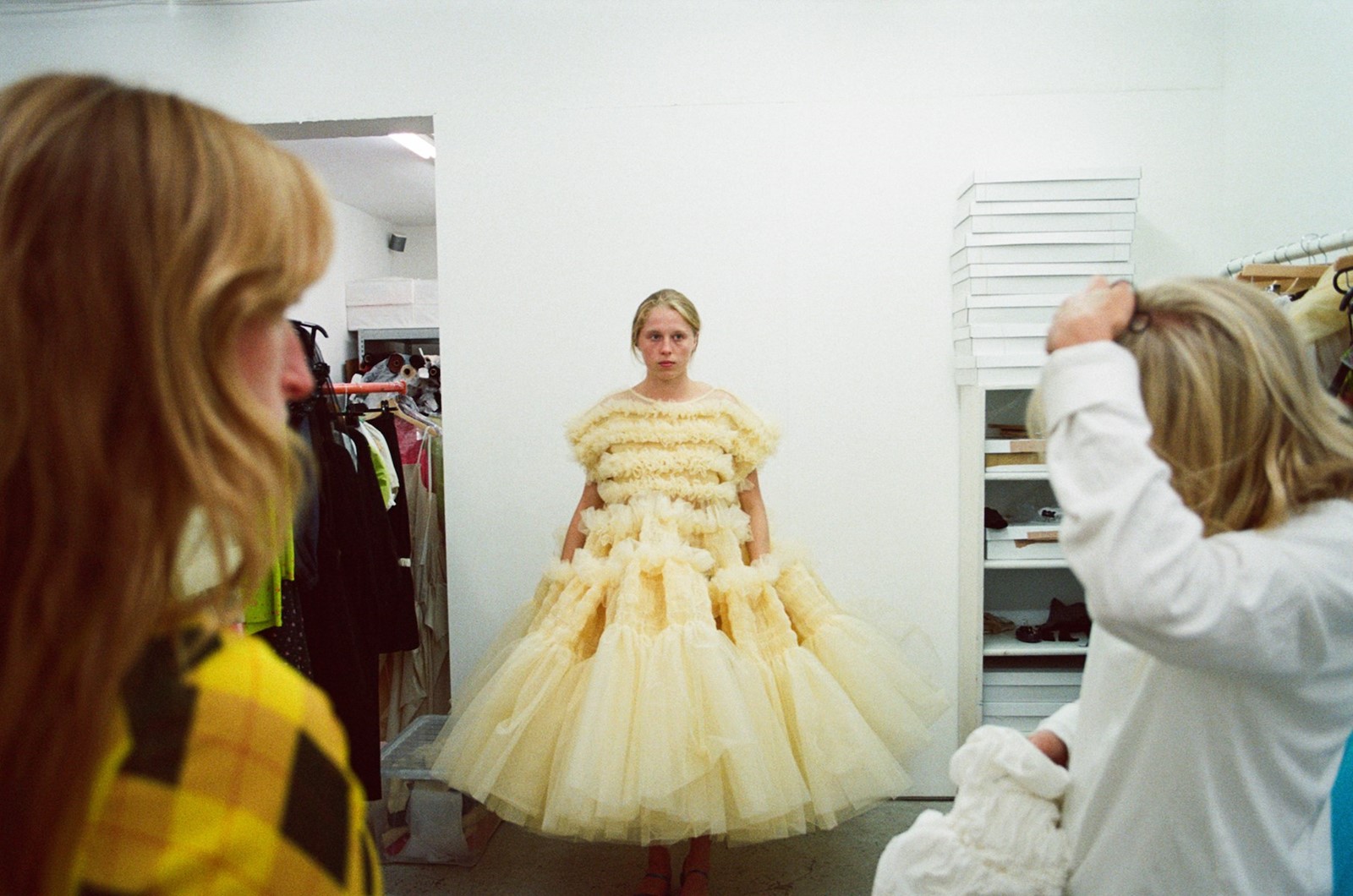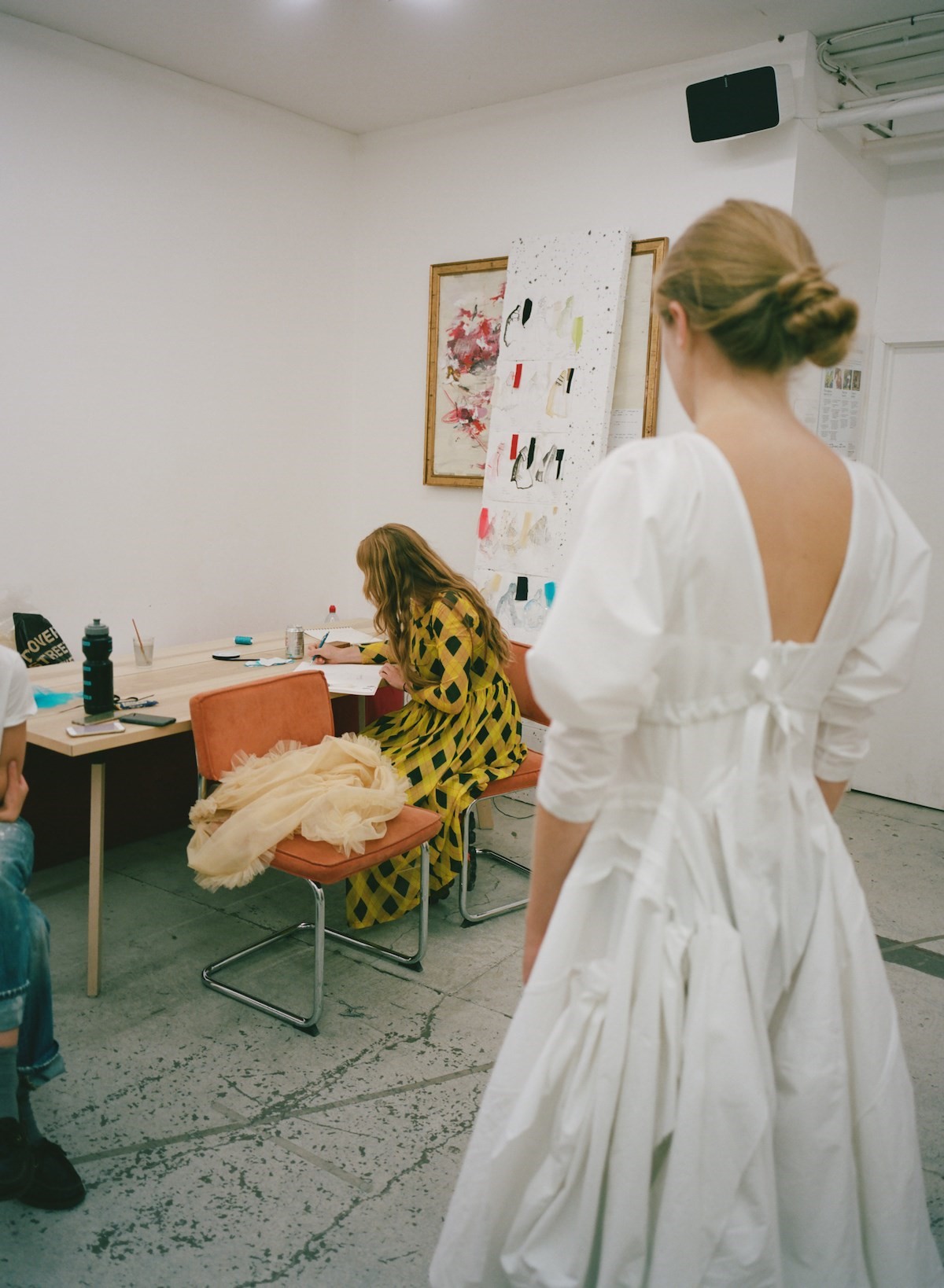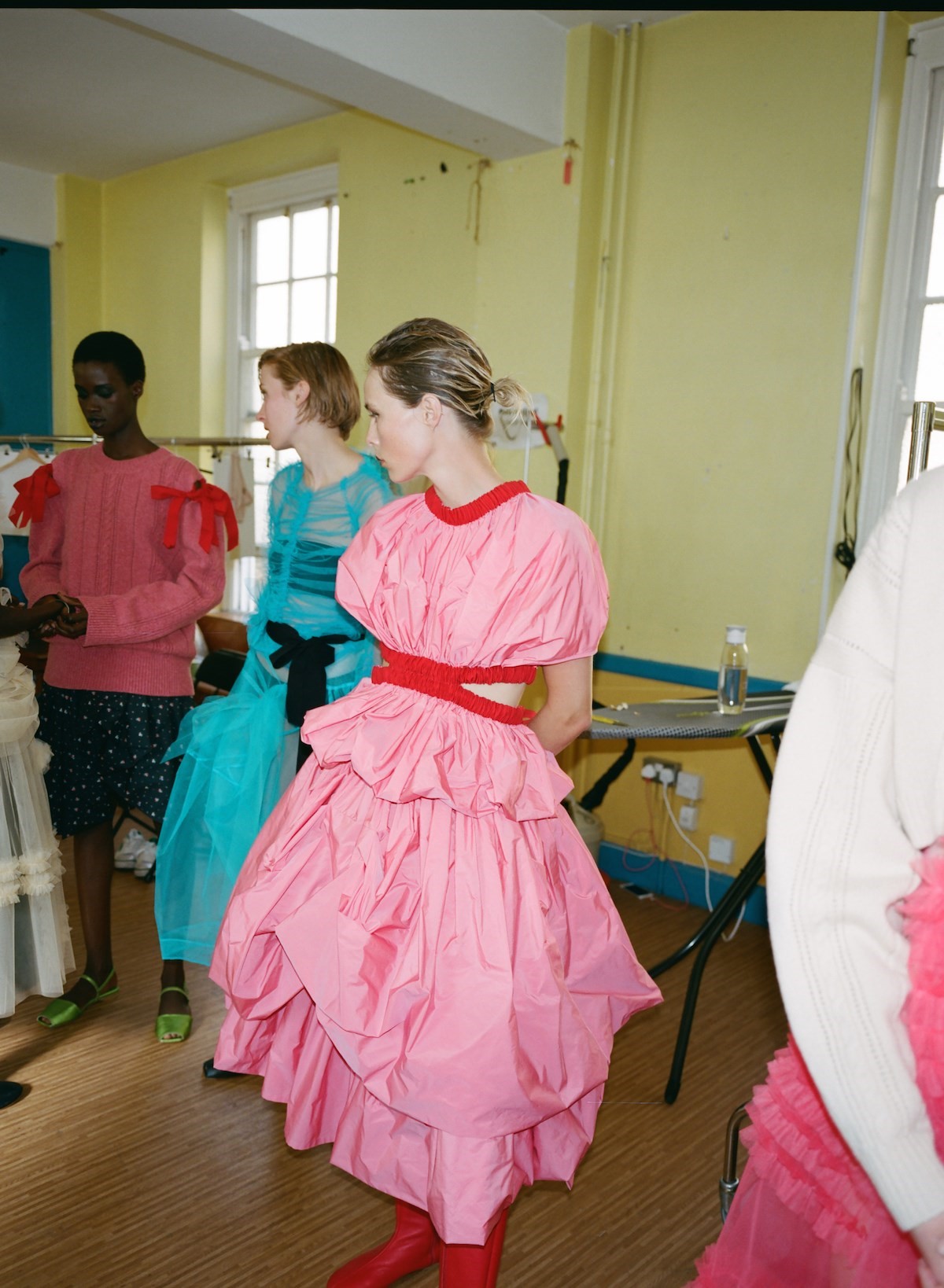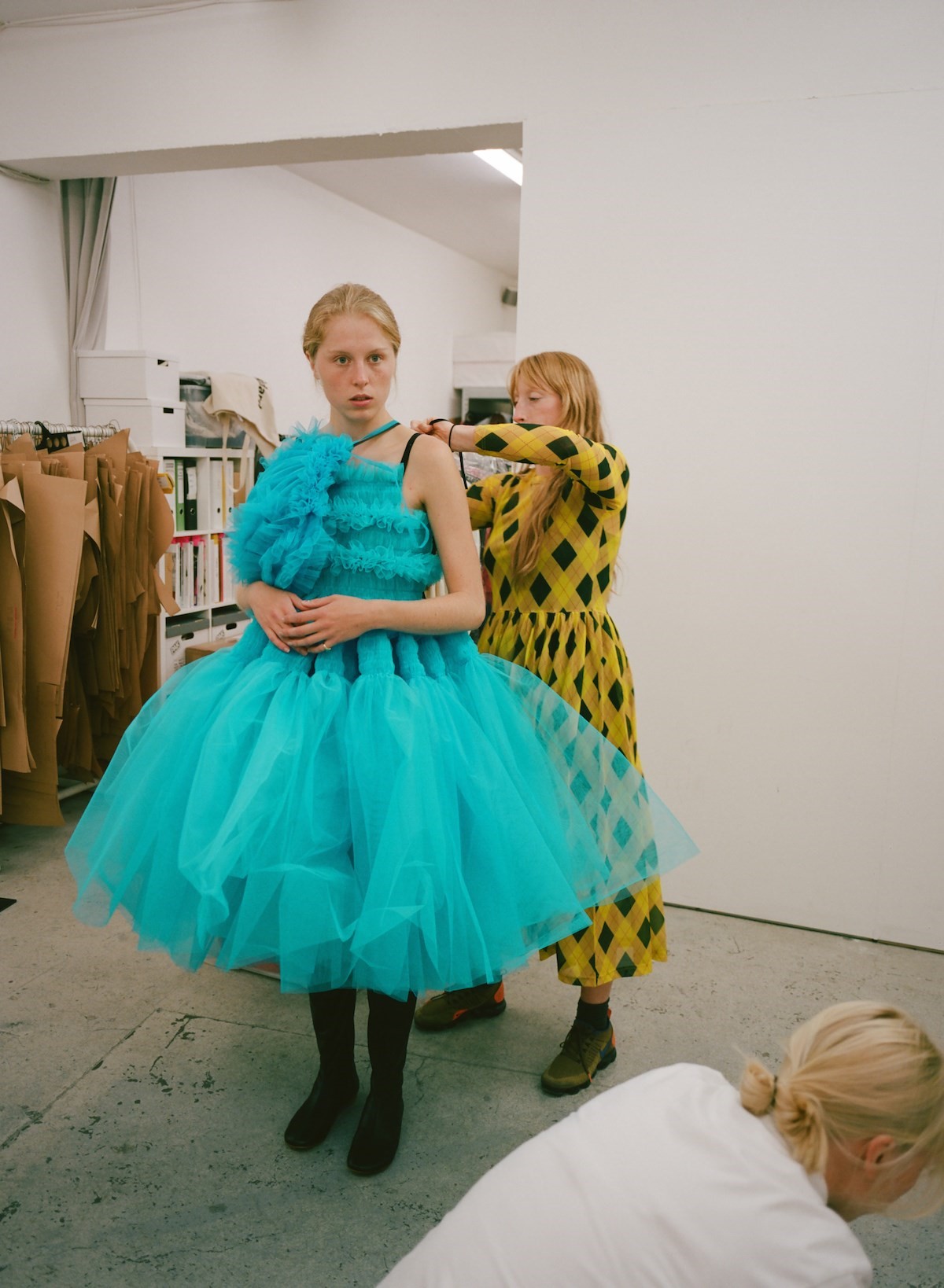This article is published as part of a new series of Designer Interviews, where we’re speaking to some of the industry’s most crucial voices about this current – and highly unique – moment in fashion history.
A new short film from Molly Goddard, directed by Tegen Williams, documents the week running up to the designer’s Spring/Summer 2020 runway show, held last summer at Seymour Leisure Centre in London’s Marylebone. In dreamy, sun-lit footage, it captures the communal effort of a fashion show: in the designer’s studio, hands run yards of coloured fabric through sewing machines, Goddard pins fronds of electric-blue tulle onto a model, conversations shift from invites to hats to hair and make-up. Then, the show itself – Williams’ swaying lens darting between the rows of packed benches, so close to the runway that the model’s gowns skim over attendees’ knees.
Which now makes it something of a memento; a document of the type of fashion show we might not see again, at least for a while. This is part of the reason why Goddard chose to release the film now: “I guess it just suddenly dawned on me recently that I don’t feel like we’ll have a situation like [that] for a really long time,” she says from her studio, which has tentatively reopened with use of a socially distanced rota. “That kind of craziness backstage when you’re all touching each other and you’re in this confined space all together.”
In an exclusive conversation for AnOther Magazine from her studio in London, Goddard tells us the story behind the film, why the fashion show remains important, and her thoughts on this current moment.
Jack Moss: Hi Molly, how are you?
Molly Goddard: I am good. I totally forgot what day it was until now ...
JM: I think everyone is in that place at the moment!
MG: We’ve started back in the studio a little bit and I think when I get here I get a little bit overexcited and forget what I’m doing, and just sort of walk around like a headless chicken [laughs].
JM: We’re here to talk about the film you’ve just released, which was taken in the run-up to your Spring/Summer 2020 show. It’s really beautiful – there’s something almost nostalgic looking back from where we are now. How did the film come about? Had you thought about documenting your process in this way before?
MG: Tegen [Williams] and Arthur [Williams] are friends I’ve known for my whole life, I suppose. Both of them have documented our shows from the very beginning – they are familiar faces, I don’t find them disturbing in any way being here. It’s always been quite nice to have them here documenting it – for the first few seasons we didn’t really take any photos of the process in the studio or backstage or anything like that, and we realised it was a waste not to be documenting everything in some way.
Tegen and Arthur first starting filming, I think, when we did the life drawing class [for Autumn/Winter 2015]. We had a male life model and did this really great, hilarious film for that presentation. I really loved it and always wanted them to come back and do it again whenever we got around to organising it. For this one, Tegen worked on it on her own – I just left her to it, I think her films are very funny. They feel very intimate – she definitely picks up on things that maybe others wouldn’t. They’re a very accurate portrayal of what the day is like in the studio ... She’s seen it from the beginning.
JM: How do you feel about being filmed?
MG: We’d sat on the film a bit because I felt a bit self-conscious that I featured in it quite heavily, which I’m not really used to! But I just got over that in the end. She’s very subtle – you often don’t realise you’re being filmed, not in a horrible way, in a really good way. So at first I wasn’t totally comfortable with it, but I really warmed to it because it’s just not really about that. It’s about everything else – that was how Tegen wanted to make the film.
JM: Obviously in between we’ve had the outbreak of Covid-19, which has put a stop to runway shows – and changed the way that designers are working entirely. I wondered looking back on the film now whether it reminds you of anything you particularly miss about life before?
MG: Yeah, I guess it just suddenly dawned on me recently that I don’t feel like we’ll have a situation like [a show] for a really long time and that just feels really sad. That kind of craziness backstage when you’re all touching each other and you’re in this confined space all together ...
JM: It’s interesting looking back now to see how much human interaction is at play at a fashion show ...
MG: Yeah. It’s nice to remember how nice it was when we could all touch each other! I think it’s quite funny thinking about it now because for that show my idea was that I wanted it to be very claustrophobic and [for] everyone to be very close. The catwalk was knee-to-knee or bench-to-bench only 80 centimetres; I wanted it to feel like everyone was almost sat on each other’s laps, and really close to the models so the dresses brushed over their legs. It’s kind of ironic ... it’s so, so different now.

JM: How important is the fashion show to you?
MG: I think for me it’s really, really important. When I start thinking about the collection, I’m picturing it; I’m picturing what the show is going to be like at the same time as I’m designing everything. I always have a quite clear visual idea of how I want the show to look from the beginning; the lighting, the mood of it, the music. It’s all totally connected. For that show, I wanted it to feel really light and bright and to feel everything was kind of busy and very detailed.
JM: You appear really calm on the film – is that reflective of how you actually feel in the run-up to the show?
MG: Yeah, I’m quite chilled on show day normally. I always get a nervous knot in my stomach but it’s almost as if you want something to go wrong so you can release some tension but nothing ever seems to go that wrong for us! I think maybe I get a bit better at them as well certainly less nervous and things are organised better. I enjoy it, it’s a good burst of adrenaline, I’m always exhausted afterwards but yeah, I’m generally quite calm. We’re all pretty calm.
JM: In terms of what’s going on now, you said that you were back in the studio ...
MG: Yeah, we’ve got a rota, there’s two to four of us in two days a week. Most people are coming in one day a week, some two, and only really those that can make it to the studio without getting on the tube. And then we are social distancing in the studio. I guess it got to a point where people couldn’t do the work they needed to do on their little table in their bedroom. Because we’ve all been working really hard from home for, I guess ten weeks now ...
“I think for me the fashion show is really, really important ... When I start thinking about the collection, I’m picturing it; I’m picturing what the show is going to be like at the same time as I’m designing everything” – Molly Goddard
JM: Before that, what was that time like at home? Did you feel like creating? And did it change the way you saw what you were doing?
MG: I think the first two weeks were a bit of crisis control, really trying to manage the situation. It was just changing constantly and, you know, a real disaster. So, the first few weeks – and still now – I was just managing. A lot of companies, a lot of little shops have gone under and you know, it’s not been great. My team has been working from home, I was really conscious of not wanting to reduce anyone’s salary or anything. I felt like the best thing for us to to was to keep working; keep being motivated.
Creatively though, it has been quite hard. I think just because it’s been so much management I’ve had do with my team, and the business, and rethinking how that works and that we’re doing the best thing we can do in the situation. It’s been a bit mad; Zoom calls every day. But it feels quite rewarding how hard everyone’s worked and how keen everyone has been to keep going.
JM: A lot of people have talked about this as a moment – either business wise or creatively – where they are getting a new perspective on how they are working, or perhaps making changes they’ve been putting off for a while. Has this been the experience for you?
MG: Yeah, I think it just highlights how messed up the fashion industry is and how the way it runs and functions isn’t particularly healthy and doesn’t really work. But it also made me feel like not forgetting what we do and why we do it and just honing in on that; scaling it back, not scaling down, just honing in on the things we do best and making sure we do those in every way. In the best way that we can – being sustainable, thinking about the brand values as a whole and how they are important to communicate.
JM: How much have you been part of wider conversations about fashion in, say, the London fashion community?
MG: I’ve been trying to talk to a few people like my London friends who are designers, and then I’ve been part of those bigger conversations that have been going on. It’s all feels quite secret at the moment, but [in terms of the fashion calendar] I’m going to wait and see.


JM: What are some of the changes you hope to see in fashion?
MG: I mean, I think it’s crazy that it’s an industry where people can sign a contract and then just decide not to honour it. I think the payment terms that there are between wholesalers and designers are pretty awful; there should be more structure to it, they shouldn’t be so fluid and flexible where they don’t have to stick to things if they just decide not to. There’s a lot that just feels really wrong in the system and no [other industry] seems to survive like that, where contracts are just redundant basically. So I really hope that changes.
I think I’ve learned a lot about how the businesses do function, but at the same time, I think we’ve been existing in quite a nice little world where we try and treat people fairly and in return, we’ve been treated fairly so far. I think I’ve been exposed to realising that this really isn’t the case for many other people so I guess I hope people become a bit fairer. Then in terms of the schedule, I actually don’t know. I really don’t know.
JM: You launched your e-store earlier this month. Tell me a little bit about how that came about – was it sped up because of what was going on?
MG: It was was something we talked about doing, it was in the plan for a while. But I think we did speed it up a bit. I guess we just also realised we had to develop our direct to consumer side a bit more – you know, there is no physical side to it right now. It was a good opportunity for us to sell things directly to consumers and get to know what they want and how they want it. So with the e-shop it’s not a case of click and buy, you click and enquire. It means that then we can give feedback, we can help with sizing and give more information about how the dress is made – I think that information gets lost when it goes straight in the shopping basket or whatever. And we’re also developing more of a custom and made to measure side of the business as well. So, it’s a big stepping stone into developing that further.
You can visit Molly Goddard’s recently opened e-store here. To discover more of Tegen Williams’ work, please visit her website.
